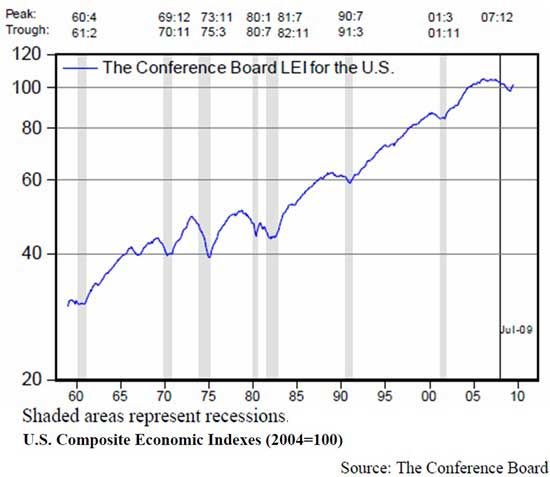The recession is bottoming out and economic activity will likely begin to recover soon, the Conference Board's composite economic indexes suggest, the Conference Board said today (pdf).
After having fallen steadily since reaching a peak in July 2007, The Conference Board Leading Economic Index (LEI) for the US has increased sharply in the last four months, with widespread strength among its components.
As a result, the six-month growth rate in the index has accelerated to its highest rate since the middle of 2004, the Conference Board reported.
Meanwhile, the decline in The Conference Board Coincident Economic Index (CEI) for the US has gradually moderated in recent months, while Lagging Economic Index (LAG) remain unchanged.
The US Leading Economic Index (LEI)
The Conference Board LEI for the US rose again in July, increasing 0.6%—its fourth consecutive increase.
The six-month change in the index was +3.0% (a 6.2% annual rate) in the period through July, with eight out of ten components advancing (diffusion index, six-month span equals 85%); that's up substantially from -2.8% (a -5.4% annual rate) for the previous six months; moreover, the strengths among the leading indicators have grown more widespread in recent months.
The Conference Board LEI for the US now stands at 101.6 (2004=100).

Six of the ten indicators that make up The Conference Board LEI for the US increased in July:
- The positive contributors were, in order, interest rate spread, average weekly initial claims for unemployment insurance (inverted), average weekly manufacturing hours, index of supplier deliveries (vendor performance), stock prices, and manufacturers' new orders for nondefense capital goods.
- The negative contributors—beginning with the largest negative contributor—were index of consumer expectations, real money supply, and building permits. The manufacturers' new orders for consumer goods and materials held steady in July.
Based on revised data, this index increased 0.8% in June and increased 1.2% in May.
The US Coincident Economic Index (CEI)
The CEI was unchanged in July, after decreasing in the previous eight consecutive months. Index levels were revised slightly lower in recent months as a result of downward revisions to personal income.
Between January and July 2009, the index fell 2.7% (a -5.4% annual rate), slower than the decline of 3.5% (a -6.8% annual rate) for the previous six months and with none of the four components advancing (diffusion index, six-month span equals 0.0%)..
The Conference Board CEI for the US now stands at 99.7 (2004=100).
Three of the four indicators that make up The Conference Board CEI for the US increased in July:
- The positive contributors to the index—beginning with the largest positive contributor—were industrial production, personal income less transfer payments, and manufacturing and trade sales.
- The negative contributor was employees on nonagricultural payrolls.
This index decreased 0.4% in June and decreased 0.4% in May.
The US Lagging Economic Index (LAG)
In July, the lagging economic index for the US fell again, decreasing 0.3%; with the coincident economic index remaining unchanged, the coincident-to-lagging ratio increased further.
(Meanwhile, real GDP fell at a 1.0% annual rate in the second quarter, following a contraction of 6.4% annual rate for the first quarter of the year.)
The Conference Board LAG for the US stands at 110.8 (2004=100).
One of the seven components of the LAG advanced, five retreated, and one remained unchanged:
- The positive contributor to the index was the ratio of consumer installment credit to personal income.
- The negative contributors—beginning with the largest negative contributor—were commercial and industrial loans outstanding, average duration of unemployment (inverted), change in labor cost per unit of output, change in CPI for services, and the ratio of manufacturing and trade inventories to sales.
- The average prime rate charged by banks held steady in July.
Based on revised data, the lagging economic index decreased 0.7% in June and decreased 0.6% in May.
About the data: The data series used to compute The Conference Board Leading Economic Index (LEI) for the US, The Conference Board Coincident Economic Index (CEI) for the US and The Conference Board Lagging Economic Index (LAG) for the US and reported are those available as of 12 noon on August 19, 2009. Some series are estimated.



